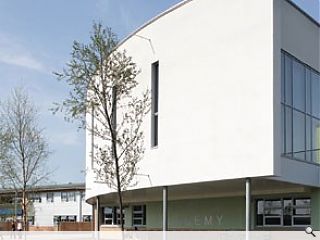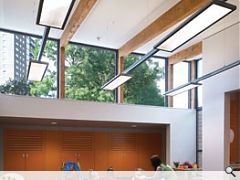School rules
26 Oct 2009
Of all challenges in architecture there are perhaps none greater than schools provision, a fact evinced by the dismal accommodation many of our children are housed within. The Scottish Futures Trust aims to change all that.
School design has weathered a tempestuous period as the political winds of change have swept through the delivery vehicles for public sector projects. An incoming SNP administration was quick to disown the PPP/PFI model but this has in turn created fresh challenges.This slowdown has been compounded by the severe economic downturn as Alex Donaldson, 3DReidÕs Head of Partnerships and a specialist in public/private procurement, explained: ÒIt really has created a massive hole in the investor and contractor markets in Scotland. There is a significant number of what we would regard as more commercially focussed contractors who have really struggled to fill that gap. YouÕre looking at a considerable reduction in the number of education projects coming to the market in Scotland, regardless of PPP/PFI falling out of favour representing a tangible loss for children.Ó Prolonging the poor quality environment of buckets in corridors and leaky flat roofs that many of us are all too familiar with.
Donaldson sympathises with the challenges facing an incoming administration with a slim majority trying to drive its agenda forward but believes the move could have been handled better: ÒWe would have liked to see them not abandon PFI completely but slope it off as the new PPP initiatives came on board. Being involved in education for almost ten years we are, like everyone else, alarmed at the poor state of the educational estate and stopping one form of procurement completely still dosenÕt seem like the best way forward.Ó
The SNP did have a go at doing just that with the Non Profit Distributing Organisation (NPDO) Public Private Projects, but this model was not particularly well received by the investment market as instead of presenting all profits to shareholders (risking public anger at fat cats running away with the money), it sought to cap profits and re-invest the remainder in community assets. It was never particularly palatable to investors who felt the significant risks inherent to PFI would not be justified by the returns.
Private Finance Initiative PPPs have come in for some stick from Architects critical of its ability to deliver good design and that it can exclude smaller practices working on their own. Notable amongst them is Alan Dunlop of gm+ad who said his practiceÕs Hazelwood School could not have been delivered under a PPP/PFI model. ÒI think AlanÕs right,Ó chimes Donaldson. ÒPPP doesnÕt neccesarilly suit small one off projects. If youÕre using the PFI initiative towards PPP then itÕs going to be difficult for a small school project to yield the profit that an investor would be looking for to offset the massive risks they take in bidding upon the open market. Sometimes they could be up against six other consortia, thatÕs an expensive competition, even in a limited field of four bidders that could be regarded as wasted money.Ó
3DReid are keen to point out that for all its bad points the PPP model can provide an excellent arena to bring skills and disciplines together in one place at one time. Donaldson enthuses: ÒItÕs not just about aesthetics, itÕs about the quality of the facilityÕs maintenance and sustainability solutions, itÕs really a pretty transparent mechanism. One of the things weÕve noticed in the design market is that architects seem to be relegating themselves to the category of designers rather than Architects and are forgetting that there are a whole lot of things that go to make a building work. Quality of design, in terms of aesthetics, is very important to us but itÕs all the other skills you can bring to the table that are even more important. In simple terms good architecture should concern itself with firmness, commodity É and delightÓ
The Scottish Futures Trust (SFT), a Government owned company that will drive new schools investment, was initially instigated around two years ago but the precise form this is ultimately going to take still has not been settled upon, even though it is intended to launch the first vanguard of projects in September. SFT will provide a new model of finance for schools procurement and aims to instil a greater design culture to public buildings with A+DS taking on a more constructive role in terms of enabling the way that Cabe does PFI down South, balancing the various strategies and systems of local authorities. Sam Cassells, education design advisor at A+DS, says: ÒArchitects should be demonstrating how design presents clients with more possibilities and will lift expectations, user participation is not an added extra and I would always encourage people to test the way a building is being used.Ó
Donaldson continues: ÒWithout any detailed information itÕs difficult to tell how we will engage, but we need the SFT as a vehicle to get investment into public procurement because it wouldnÕt appear that we are going to get everything from Capital funds. Some money is going to have to come from elsewhere. The public sector will always struggle with delivering vast sums of capital in the right place at the right time. The SNP are fully aware of this, which is reassuring. It all seems to be about how the public benefit from the right form of private investment being delivered for these projects.
School design has long captivated Donaldson for its multitude of complexities, from dealing with a range of ages, abilities and learning styles all set against a curriculum in constant change. Donaldson states: ÒWeÕre very much at a fulcrum in the Scottish education system. We are all moving from the traditional mode of learning established over the past 15-20 years and are actively exploring new ways and methods of learning. The ÔCurriculum For ExcellenceÕ for instance is essentially about creating realistic outcomes for children. We may not all be great Scientists or Mathematicians but where is the next head of Stagecoach going to come from? Great business leaders and innovators are not always necessarily high ÒattainersÓ at school but possess a raw desire to get on in life. Our education system should attempt to recognise talent in all its forms and nurture it.Ó
3DReidÕs Clackmannanshire school is a key example of this approach where the continental peripatetic model where teachers move around and the pupils all stay in the same place, was investigated to ease congestion and maximise classroom time. ÒClackmannanshire werenÕt ready for it however seeing locking people up for long periods as being detrimental to behaviour,Ó recalls Donaldson.
ÒIt is not just the radical that drives good design. We often rush to the brand new or the untried when we think of transformation, but how we change what we have already committed to is just as important. One PPP school singled out for attention is an established school, Balfron, for two very simple reasons, the designÕs ability to adapt and the vital role of staff.
ÒThe School management developed from a department style to reinforce the faculty / house organisation, this approach led to a care or peer structure through the years which is a good way of breaking down massive populations, creating identity and personalising the school environment for the individual. This demonstrates that school design is as much about the school responding to the design as the design responding to the school.Ó
Donaldson believes that many architects have fallen into a trap of attempting to be innovators; this approach is turned on its head at 3DReid where the practice requests that learners and educators show the innovation to which they will design around. ÒWe dance to the tune played by others and if you look out across the dance floor youÕll see a lot of designers falling over themselves because theyÕre not listening. We like to think that we listen and produce what weÕre asked to produce rather than put alternative models in front of people which can confuse and ultimately may become dysfunctional. As Technical and Client Design Advisors we often hear the client say that designers have gone too far, have not listened to what they have been told and that present education models are confusing and just donÕt seem to workÓ. The message from many local auhorities seems to be, Ôlisten to what we want and work with us to achieve thisÕ.
In the case of co Ðlocated schools, integration of distinct cultural groups and the role segregation plays in the fragmentation of society remain live issues for schooling in the 21st century, even in such celebrated schools as Craigmillar Primary in Edinburgh, often cited as one of the few examples of the dog wagging the tail in the marriage of social infrastructure and community regeneration. Despite bringing non denominational and Catholic pupils together on one campus, many services remain duplicated such as twin receptions and split wings of teaching accommodation, both of which would seem illogical. Donaldson says: ÒItÕs always going to be a complex issue for two cultures to come together in the same place regardless of their cultural or religious focus. People naturally become uncomfortable with things they perceive as different and this does happen in schools. There are precious few examples of successful integration so maybe we shouldnÕt be trying too hard to force integration, if it will not naturally happen. ItÕs a socio/cultural thing and expecting schools to sort it out is a little disingenuous. If two communities want to come together in the same school there will probably be very few problems, perhaps just accepting that youÕve got two schools on the one site might be one solution. Maybe differences are special, maybe itÕs nice to have different types of school.Ó
ItÕs undoubtedly a difficult time for local authorities who havenÕt designed schools in-house for a very long time. In the 40/50/60s local authority technical departments did so but today these resources arenÕt sufficient to roll out a large programme of schools building. For local authorities to take these projects all the way through, there is always going to be a certain amount of resistance on the part of the commercial sector to employ the local authority architect all the way through.
ItÕs often construed that the commercial sector are more proficient in design and build than local authority architects, but 3DReid have seen a considerable benefit from engaging with local authority architects: ÒItÕs a marvellous arena for both the public sector and private sector architect to come on board with a meeting of minds. The public sector does sometimes have different drivers, quite rightly so, and the successful fusion of ideas and ethos represented by this soft form of public / private collaboration can be extremely rewardingÓ
Across much of Scotland a process of schools rationalisation is underway where dilapidated stock is torn down in favour of fewer larger schools to much local protest, particularly in Glasgow where many are fearful of the heart of their communities being ripped out, placing pressure on the rolls of neighbouring schools and the politically sensitive pupils per class and teacher/pupil ratio. Donaldson says: ÒEveryone seems to want a shiny new school and refurbishment seems to be a bit of a dirty word, almost the second best alternative. This is wrong though, Designers often find that you can get closer to the sustainability agenda when dealing with refurbishment.Ó
A lot of focus is on pupils per classroom and the SNP manifesto was to reduce classrooms down to 20, yet the continued practice of closing schools operating at 50% efficiency is creating a dichotomy. A solution if there was enough money would be not to close any more schools but the education sector is rather cruelly driven by the commercial sector.
Secured by Design has come in for stick in some quarters with civil liberties campaigners lamenting the remorseless march of CCTV, but as parents become increasingly concerned as to perceived crime rates the need to tackle antisocial behaviour through design becomes more acute. Donaldson remarks: ÒThe Police and emergency services are only interested in our safety so I would always say weÕve got to listen to what these people say. ItÕs a bit of a bind when weÕve got to put a 2.4m high palisade fence all the way round the school but this is for safety and insurance reasons. Without a barrier that people have to step across it makes it very difficult for the police to do their job. Drugs, knife crime and violence have become an abhorrent problem in inner city areas and they require daily workable solutions. The safety of children and teachers is paramount.
ÒWhen most of us went to school it was legal to get the belt. That form of punishment was readily accepted then ,but we now as a society no longer accept that physical violence is a solution. WeÕve moved back from a disciplinarian stance so it might seem that discipline is a greater problem than it used to be but there was probably just as high truancy then as there is now.Ó
Sustainability is still very much the industry buzz at the moment and at 3DReid the story is no different. There ,regular Sustainability Workshops are run, most recently a zero carbon ÒThinking BreakfastÓ which has delivered some surprising results such as the claim that British schools were thought of as further on than their counterparts in the Scandinavian market; despite a Ògrass is greenerÓ mentality in Britain.
Donaldson advises when it comes to controlling 3DReidÕs approach to the sustainability agenda they adopt a rather dry, scientific approach: ÒWe conduct a live cost analysis of all the capital, operational expenditure and the whole life cycle costs and maintain this analysis throughout the inception, design and delivery stages of the project. We shouldnÕt be designing a school for just 30 years.
Delivering real sustainability is about delivering enough money at day one to ensure that all the environmental initiatives are built in and can be maintained. If we sit back and do not demonstrate the long term value of our approach to design, corners will be cut. If given the opportunity to make profit and have a very sustainable building to boot it makes it an infinitely more marketable product. This all may seem very cold and hard but unless we all value long term sustainability, we may not ever appreciate or realise the benefit.Ó
|
|
Read next: Roses flower in Nottingham
Read previous: Mo town low down
Back to October 2009
Browse Features Archive
Search
News
For more news from the industry visit our News section.
Features & Reports
For more information from the industry visit our Features & Reports section.






